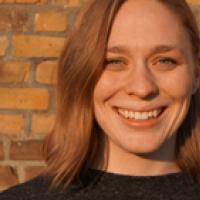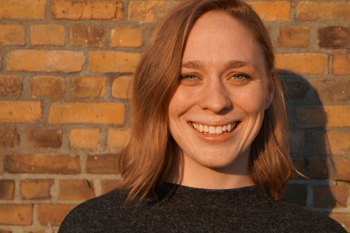
Mathematical snapshots: Tamara Grossmann
Tamara Grossmann is a final year PhD student at the Cantab Capital Institute for the Mathematics of Information (CCIMI), which is based in the maths department of the University of Cambridge. Here she tells us about her work in image analysis, a typical day as a researcher, and her role in encouraging more women and non-binary people into the field.
Generally, my area of research is image analysis and image processing. This involves looking at classical numerical methods for solving these problems but also combining them with new techniques from machine learning, which has become very popular recently. More specifically I am looking at partial differential equations related to imaging tasks.
As an example, think about an image of a donut with sprinkles on it. There is a method called spectral total variation decomposition which separates the structures in the image based on their size and their contrast. So for the donut that means it will separate the image into the dough part of the donut and the sprinkles — because the sprinkles are smaller it can separate them out.

Tamara Grossmann.
To be able to get this decomposition you need to solve the total variation flow — a partial differential equation. This is commonly done using classical numerical methods but in this case these can be very slow, especially for large images or if you need to process a great number of images. I am looking into developing faster methods by harnessing a form of machine learning called deep learning.
There is a wide range of applications for spectral total variation decomposition: from removing noise in images to fusing two images together like faces or brain scans from different imaging sources.
The work on image processing has led me to look into using deep learning techniques to solve general partial differential equations — where does deep learning have advantages, but also where does it make sense to employ classical numerical methods that are typically much better understood.
You can find out more about machine learning in this article, about deep learning in this article, and about differential equations in this article.
It's the applications that attracted me to this area. I did my undergraduate degree in Münster, Germany, and they ran an event called Maths offers Perspectives. An alumnus working at an imaging company presented there — at that point I didn't know that you could do something so applied with this theoretical subject that maths was to me. I thought, "this is really cool, I can do something that I can see the impact of with very theoretical tools." That's what made me want to work in that area. I love the applications.
I really enjoy the social aspect of working at CCIMI. You always have people you can go to with questions or who will sit with you and think through your problem. I have seen people starting collaborations just by starting to informally chat about mathematical ideas and problems. It is a very supportive environment.
Being part of CCIMI also offers a lot of other opportunities. Around two years ago, for example, we realised that there were only a few women PhD students at CCIMI. So I started talking to my supervisor Carola-Bibiane Schönlieb and Josh Stevens, then the coordinator of CCIMI, and together we came up with the Philippa Fawcett internship programme. It enables women and non-binary undergraduate and Masters students to experience life as a researcher. CCIMI was able to provide funding for it by incorporating it into an existing internship programme.
Not many research groups or institutes are able to facilitate this kind of opportunity.
To find out more about the Philippa Fawcett internships, see this article.
I am very much a planner, so a typical day starts by looking at my to-do list. In the morning I usually take care of emails, and then, depending on what stage I am at in a project, it's either literature reviews — reading and getting to know the project — or coding, looking at results and figuring out what I need to change, or writing up my results.
It's always a mix but I would say that coding forms the biggest part of my day.
One of my favourite mathematical moments is when suddenly everything comes together and starts working. Around two years ago, after I had been working on a project for quite some time with seemingly no progress and a lot of frustration on my side, all the little parts I had been working on started to click together. Coding can involve many bugs, sometimes the model needs adjusting and refinement and especially in the beginning all the possible problems can seem very daunting.
After working through several issues, and feeling somewhat lost in the midst of all the different avenues to explore for solving the problem, that work paid off. My code started working and the model produced results that were actually good. It was a huge relief! It's always amazing when ideas and models turn into reality, the maths works out and you get to produce images just like you intended.